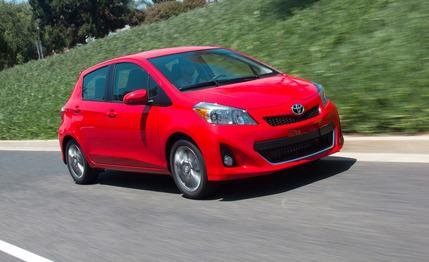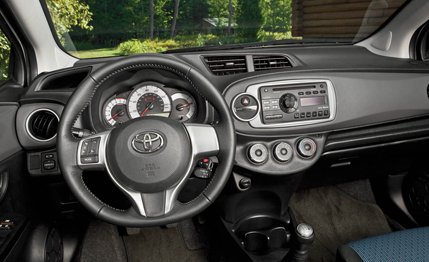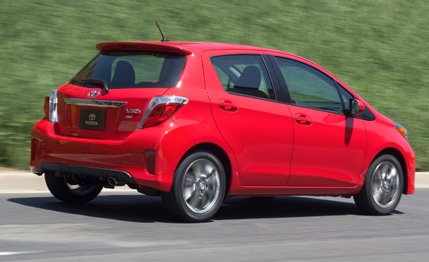
 Instrumented Test
Instrumented Test


Where does driver comfort rank in the grand scheme of the automotive experience? Pretty high, we think, even if you’re spending less than $20,000 on what would otherwise be considered A-to-B transportation. And so we’re perplexed that Toyota seemingly overlooked the seating position in its new Yaris.
Even though the sporty Yaris SE tested here includes an adjustable-height driver’s seat, you’re always sitting fairly high and hunched over. Unlike in most other cars in this class, there’s no telescoping function for the steering column, so you must slide forward and have your knees bent at an uncomfortable angle (good thing there’s a driver’s knee airbag) or slide back and reeeeeach for the wheel. Neither option bodes well for long-distance comfort. If the tiller offered fore-and-aft motion, comfort would run at the top of the class, rivaling that of Chevy’s new Sonic.
At least the majority of the car seems thoroughly vetted. Unlike the dull cabins found in competitors like the Nissan Versa or 10Best-winning Honda Fit, the Yaris’s clubroom appears to have actually been designed. The materials are much improved over the previous-generation car’s, the three-knob HVAC controls are a simple solution, and the dash gets “rice paper” graining.
The exterior has some style, too, although opinions were divided in our office as to whether it’s actually stylish—we’ll let you judge for yourself whether the looks appeal to your pleasure center. It kind of looks like a sedan was squeezed lengthwise in a vise and the pressure popped the hood up and left two bulbous saddlebags in place of the rear quarters. Either way, we welcome the change from the previous Yaris’s slab-sided, forget-me-now looks, and the SE’s standard dark-finish 16-inch aluminum wheels add a little extra visual pop.


The overall length is the shortest in the class, but the back seat doesn’t feel too cramped—its 38 cubic feet of passenger space is second in class to the Fit. But the Honda still rules by far for overall comfort, pulling an M.C. Escher–like feat and somehow offering more interior space than seems physically possible.
Loud and Slow Powertrain, Nimble and Willing Chassis
All Yarises are motivated by a 106-hp, 1.5-liter inline-four, and our SE test car was fitted with a five-speed manual. If one so desires, a four-speed automatic can be optioned for $800. We found the operation of the manual to be above par for the segment. Gearchanges are positive, where you can feel the synchros, well, synchronizing gears, and clutch takeup is predictable if a bit numb given the meager 103 lb-ft of torque on tap.


The combination of the lowest power in the segment and a five-speed gearbox—many competitors offer nearly 140 horses and six-speed transmissions—results in subpar acceleration. Sixty mph comes after nine ticks of the second hand, and the quarter-mile takes 17.0. Although the Yaris is quicker than a Nissan Versa or automatic Kia Rio, the Fit, the Sonic Turbo, and the Hyundai Accent are swifter by at least 0.5 second in either metric. This is a little surprising because the Yaris is a relative featherweight in its class; at 2375 pounds, it weighs some 430 less than a turbocharged Sonic hatch. Further, the powertrain is incredibly noisy. Fifth gear returns just 22.6 mph per 1000 rpm. So in addition to wind and tire noise, driver and passengers listen to the little four-banger’s 3100-rpm wail at 70 mph, all to the tune of 73 decibels.
But let’s get back to the positives. The light curb weight pays off in great handling. In our most recent economy-car comparison test, the Yaris repeatedly amazed with its so-very-un-Toyota-like eagerness in cornering. On the skidpad, where the Yaris posted a commendable 0.79 g, the steering felt slow, but it was livelier, more communicative, and more direct on the road and in our slalom test, where it was topped only by the Fit. (The SE is fitted with quicker steering than the rest of the Yaris lineup; rear disc brakes also make it unique among its drum-equipped brethren.)


The low curb weight and the careful attention to aerodynamics help the Yaris achieve commendable mileage numbers. Although it can’t touch the Hyundai Accent/Kia Rio duo’s 40-mpg highway figure, it falls just 2 mpg short. The little Toyota ties the Koreans in the city at 30 mpg. The Yaris therefore roundly beats the 27/33 ratings achieved by a five-speed manual Fit and returned 33 mpg in our hands.
Pricing is another Yaris strong suit. At $17,160, the SE model undercuts a similarly equipped Fit Sport by $520. That might not seem like a lot, but even that small amount could make or break a deal for a recent college grad with marginal credit. The other shining star at this general price point is the Sonic, although its top-tier LTZ model costs more (while bringing more standard doodads).
Comparing the old Yaris with this new one would be unfair. The 2012 is better in every regard. The vast improvements haven’t quite catapulted the entry-level hatch to the top of the heap—that’s how bad the outgoing car was—but it’s within arm’s reach. And it might be even closer if our arms didn’t have to reach so far while driving it.